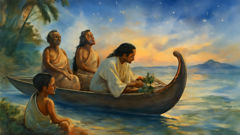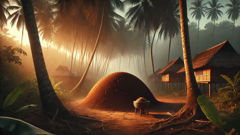Introduction
Before the sea wore its blue skin and before the palms counted the passage of years, when the world was a quiet thing of potential and waiting, Vatea and Papa lay close at the edge of nothing and everything. Vatea, whose hair was the arch of day and whose voice carried the breadth of sky, possessed the calm, clean patience of wind. Papa, whose skin was dark with the memory of fertile earth and whose breath smelled of rain and fruit, rooted everything to sense and soil. Between them there was a hush like the held breath of a village at dusk; from that hush grew first murmurs, then songs, and finally offspring who would shape land, sea, and the lives of their descendants. Their union was not merely of flesh but of purpose: Vatea spread the vault of possibilities above, Papa gathered the substance beneath. From their meeting came the gods—children with names that were promises: Tangaroa, whose hands cupped the sea; Rongo, who taught planting’s gentle art; Tane, whose fingers braided forests into shelter; and others whose small contradictions held the world in balance. In the beginning, the islands had no names, and the people had no stories. It was the rhythm of these first births, the argument of wind with soil, that threw up the first reefs and lifted the coral into peaks. This is a telling of that first time—how light and mud, salt and sap, song and silence braided together into the Cook Islands, and how the law of kinship and the measure of seasons came to be written in stone, tide, and the tilt of palms.
The First Children: Gods of Sea, Forest, and Harvest
When Vatea and Papa first named their children, the names were like commands that the world obeyed. Tangaroa burst from the place where Papa’s wet loam met Vatea’s breath; he came with fingers long as paddlestaves and hair threaded with seaweed. Where he walked the waters listened and learned to answer. The waves learned to remember journeys, and shells kept secrets of navigation in their spiral memory. Tangaroa’s laughter turned into reef and current; his anger, rarely shown, could toss whole canoes. He loved the deep and the secret places where fish nested, and so ocean maps grew in the heads of navigators who honored him with carved voyaging prows and the quiet placing of offerings into moonlit surf.

Between the first and second breaths of the world, Rongo opened his eyes. He was small and steady and smelled of cooked taro and sweet fruit. Where he walked, tiny green things grew bolder. He taught the hands of the people how to press seed into soil, how to coax root and stem, how to watch for the right moon to plant beneath. Rongo's children taught rhythm—how planting must follow a song, how harvests respond to the cadence of prayer. His temples were low and warm, built of earth and woven leaves, and inside them the first kalo beds were tended. People learned to give back, to leave a portion of harvest on the ground for the hungry spirits who moved between furrows by night.
Tane, who followed, braided the first forests from scattered sticks and lianas. His thumbs were quick and his laugh ran through canopies like wind. He brought birds that would sing the names of places and insects that kept the soil soft. Tane’s hands were patient; under his guidance, groves learned to hold rain and to protect springs. He taught people the woodcraft of house and canoe, how to read grain and knot; his lessons were written in the curl of rafters and the fashioning of paddles that skim the lagoon. Between Tangaroa’s currents and Tane’s shade, the islands took shape, rimmed with reef and crowned with tree.
But not all of Vatea and Papa’s children moved with gentle hands. There were gods who kept watch on storms and who measured loss so life could learn its limits. The sea had less gentle rulers whose tempers reminded people to mend nets, to tie strong lashings, to respect the silence of the deep. Their presence taught a hard, useful lesson: life on islands is a careful negotiation, a weaving of risk with gratitude. Vatea and Papa watched and argued sometimes—sky proposing expanses, earth offering resistance. Those arguments birthed the winds that shifted reefs and the tides that smoked the sand at new moons.
Among these divine children were midwives of law and of song. One taught the people how to speak to ancestors and to read omens in the flight of birds. Another invented the first kapa cloth, putting pattern and memory into cloth so a story could be folded and carried. When people learned those ways, they were not simply surviving; they were making time itself reliable, shaping rites that would travel across canoes and generations. Vatea’s broad arm learned to measure the steps of calendar and season, while Papa’s slow hand pressed wealth into soil and bone. The gods taught songs for birth and for funeral, for planting and for canoe launch; each song bound the islands back to their parents and to each other.
The living islands grew by consent and contest: shallow reefs becoming rubble islands, coral piled into shoulders above salt; palms taking hold where cracks in rock caught seeds and bird droppings. Papa’s patience was the true engineer: she gathered the fragments and promised them a place in the making. Vatea’s breath, light and persistent, coaxed rain from distant horizons. When a storm came and seemed to unmake a shore, the gods would step in to rearrange the loss into a different kind of abundance—an inlet, a lagoon, a new shelf where fish would hide. This was their economy: ebb and gift, removal and return. People who listened learned to offer thanks before harvest, to build houses that breathed with the sea, to place stones in memory of kin and event.
In villages that grew at the feet of cliffs and beneath banyan shade, elders traced their genealogies back to Vatea and Papa not as abstract names but as laws: the sky father gave sight and boundaries; the earth mother gave substance and claim. Chiefs learned to speak as children of Vatea, authoritative and far-reaching; clan mothers spoke like Papa, keeping hearth and lineage sealed. Their myths structured life. The first taboos—what not to eat, where not to walk, when not to fish—were born to keep balance between the demands of gods and the needs of people. Violating these laws, the elders taught, would invite misfortune: fish would shy from nets, storms would find open ribs of houses, or crops would fail. So ritual, law, and story braided together, and each island kept its own shade of the tale as the people adapted to reefs, rivers, and cliffs.
Trade and gift tied islands together. Where wind and current allowed, canoes carried artisans and priests; they carried songs and taro slips. The gods, siblings though they were, gave different favors to different shores. Some islands became known for their deft navigators, others for the sweetness of kava grown in their valleys, others for cliffs that hosted birds of a hundred colors. Yet all kept the same origin: a sky and an earth who loved and whose love was a making. The Cook Islands’ geography, with its scattered atolls and volcanic peaks, reads like the signature of that first encounter—places where ocean and sky meet as if to bless the world with possibility. Each beach and ridge is a punctuation in a long sentence that began with Vatea and Papa. Their children continued to craft details: the moon’s measure for planting, the star paths for canoeing, the forms of welcome when strangers arrived. In that way the myth was not merely a story but a map written into memory, guiding people through change and through seasons of plenty and want.
People told the tale to children beneath woven roofs, their hands moving the same way that Vatea’s clouds might move: elaborate, gentle, instructive. Songs came with the story—melodies shaped to fit the work of paddling, planting, and spinning. Even the simplest fisherman’s chant carried notes that echoed naming ceremonies performed long ago when the first reef found its height. Thus the myth stayed alive: retold, reshaped, but always a tether. It reminded listeners where they were from, and it taught how to be on islands that were, by nature, places of both shelter and exposure. Vatea and Papa’s decisions were still practical matters for people: choosing where to plant, when to harvest, how to honor a drowned ancestor. The gods were not distant—they were immediate, in salt on the lips and in the slow turning of the taro leaves under dew.
And when a child in any village asked why the moon’s face changed, an elder would answer with one of Vatea’s whims and Papa’s reciprocation: the moon learns different faces to teach patience; the tide rises and falls so that people will not take the sea’s riches for granted. The world that Vatea and Papa built was therefore a classroom: every day a lesson, every season a parable. Those lessons shaped law, art, and the quiet courtesies between neighbor and neighbor. In this way, the Cook Islands were carved into a culture of attentive care, a culture born from the first household of sky and soil.
Tides of Law and Song: How Ritual Wove the Islands Together
Ritual appears in the story of Vatea and Papa not as ornament but as the mechanism by which the world continued to be named and honored. After the initial making, there was work to be done: the gods taught the people ceremonies that would keep balance between the seen and the unseen. The first rites were practical acts with words attached—phrases that made sense of how sun warmed planted rows, how rain corrected a dry stomach, and how to ask for safe passage when crossing the wide Pacific. Those early formulas, whispered first to chiefs and elders, learned mouths and traveled across reefs as both prayer and contract.

Canoe launchings became sacred festivals. Before a hull slid into water, men and women wrapped themselves in kapa and their voices called to Tangaroa for calm. They laid offerings of breadfruit and shell upon the prow, and the priest recited genealogies that tied the canoe not only to its carpenter but to Vatea above and Papa below. A canoe, in these ceremonies, became the throat of community: a vessel of harvest, a bearer of dreams, and an instrument of survival across distance. Those who navigated stars did so with songs that were maps; the songlines were as critical as oars, and a lost song meant a lost path.
Naming ceremonies fixed individuals into the cosmology. A newborn’s name linked them to one of the first gods—a child might be called for the sea’s generosity or for the patient steadiness of an elder grove. That name established obligations: to tend certain fisheries, to keep certain groves, to maintain memory of a particular ancestor. The social contracts written into names prevented the chaos of unanchored lives. Families measured their rights and duties against those ancestral lines, and disputes could be reconciled by returning to the original mythic logic: Vatea’s sense of horizon and Papa’s gift of soil. Elders mediated, invoking lineage to calm rivalries and restore balance. In this sense the myth functioned like a constitution, its verses read when people needed legal or moral clarity.
Seasonal festivals became calendars and calendars became survival tools. Planting festivals coincided with whispers to Rongo; the first rains after a drought were a time to sing long songs to Papa and to share the new tubers with the gods. The harvest time was solemn and joyful, a communal account of debts and gifts that sustained both the living and the unseen. Even funerary rites followed the myth’s logic: ashes or bones returned to hidden earth niches so Papa might receive the dead, while sky-oriented chants asked Vatea to widen the ancestor’s vision. In those moments the community learned to accept loss as part of continuity, to rehearse grief within patterns that led to restoration rather than mere sorrow.
The law of taboo took shape from small, careful observations. If a particular reef swallowed more nets after indifferent fishing, the elders would declare restriction—a rule that might keep people from fish-spoiling behaviors and would give fish time to multiply. These taboos often read like commonsense ecology, and the gods’ stories supplied the moral imperative that made them stick. They were not merely prohibitions but invitations to care: by abstaining from certain catches, communities preserved breeding grounds; by refraining from cutting particular trees during nesting season, they preserved seeds of future groves. Vatea and Papa’s myth thus had ecological wisdom embedded within its moral language, a set of rules that ensured islands could sustain people and gods alike.
Art and craft grew from ritual practice. Woodcarving took on patterns that recalled wave and leaf; tattooing spoke of lineage and the right to certain resources; weaving recorded journeys and agreements. Artists became keepers of law in their own medium: the patterns they embroidered into kapa told who might fish where, who could sit at a certain mat, and what names must be invoked during rites. A woven cloth could be a legal record, a dowry, and a map of kinship, all at once. In this way the myth’s influence spread into daily life, into the grain of a paddle or the stitch of a house wall.
Conflict between islands was managed by ritual exchange as well as by negotiation. Gifts were not mere tokens but legal instruments that could restore honor and renegotiate debt. When a wrong had been done—an insult to an elder, an offense at sea—delegations carried song and taro as they sought to rebalance relations. Sometimes reconciliation required the risk of giving valuable items away; thus generosity became an economic stabilizer. Chiefs were judged by their capacity to see that their people kept both local and inter-island obligations: to mend nets and to mend words. Many sagas recorded how the right performance in a ceremonial context turned a potential war into a marriage or partnership, the social fabric reknit by careful words and sustained gifts.
Legends of navigation threaded islands into intimate kin. Star routes, wind codes, and swell-reading belonged to families who kept them like heirlooms. Those who taught the songs in the dark of night were revered as both artisans and guardians; their chants guided canoes across open water and back into the safe mouths of lagoon. Navigation ceremonies involved invoking Vatea to steady the heavens and Papa to open a safe mouth in the reef for return. These rites recognized that crossing the ocean required more than skill; it required the world’s consent. When canoes returned with new plants or seeds, they introduced deliberate diversity, and islands changed in small, intentional ways.
Language itself preserved the myth’s power. Proverbs derived from stories of Vatea and Papa functioned as compressed law: warnings against hubris, reminders to keep promises, small instructions about how to treat kin and stranger. Wise sayings about the sea’s mood or the right time to plant spoke to a people who lived with constant and subtle environmental pressures. Those proverbs were taught young and often repeated in daily life, shaping character and action quietly but relentlessly. They ensured that the myth’s lessons were not just told but practiced.
Ultimately, the myth of Vatea and Papa is less about the past as a static backdrop and more about a continuing conversation between human activity and the island environment. The gods may have been born at the first meeting of sky and earth, yet their teachings—embodied in ritual, law, and song—remain practical tools for living. The Cook Islands, in this telling, are less a completed product and more an ongoing project: a community practicing attentiveness, learning to balance want with restraint, abundance with giving back. The myth remains alive because people keep it alive, using its verses to steward reefs, to launch canoes, to plant youth into elder care. In that living exchange, Vatea and Papa’s first breath continues to move through every household, every reef, and every star-led voyage.
Conclusion
The tale of Vatea and Papa is a living map: not merely a story for telling but a manual for being. When islands are spoken of as children of sky and earth, the language charges daily life with a delicate ethics. People learn to treat the sea as kin, to understand storms as rebuke and reward, and to anchor social ties in ceremonial exchange. The Cook Islands’ identity—marked by long canoe journeys, reef knowledge, cultivated terraces, and woven narratives—springs from that first meeting of breath and soil. The gods born of Vatea and Papa did more than shape geography; they provided names and laws that guided how to plant, how to launch, how to mourn, and how to celebrate. In every reef stacked by patient coral, in every paddled voyage, in the low chanting of elders, their presence is felt. To listen to this myth is to learn a practice of stewardship: to give thanks, to follow seasons, and to pass songs forward so that the islands remain both home and teacher. Even now, when a child sings to the moon or a navigator reads the swell, the old voices answer. The world remains under construction and under care, and that continuous work—love and attention made practical—remains the truest inheritance of Vatea and Papa.













